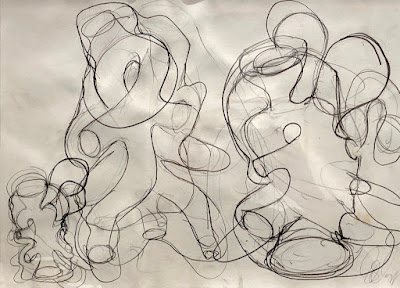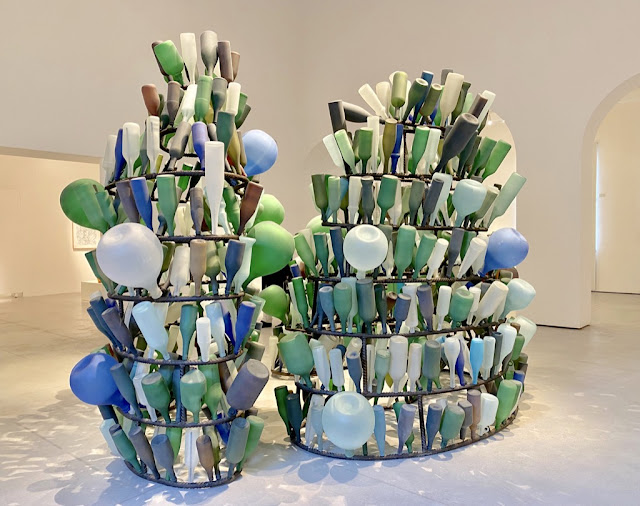Museo del Vetro di Murano
Tony Cragg - Silicon Dioxide
At the Museo del Vetro di Murano the new solo exhibition - Tony Cragg - Silicon Dioxide is curated by Adriano Berengo, Berengo Studio in collaboration with the Musei Civici di Venezia and runs through March 13. A selection of about forty sculptures are on display, they faithfully reproduces Cragg's artistic
vision and his unique ability to communicate through glass, a material of which
he has always been able to enhance the intrinsic geometries. The exhibition
traces the most significant stages of the English artist's career,
starting with the assemblages, historical large-scale works where small groups
of objects are juxtaposed and superimposed. It is from this point, as early as
the 1980s with his large-scale sculptural assemblages, that Cragg began to
define his artistic output through his interest in the material itself. Cragg
continually tests himself with his use of different materials, and
glass is certainly one of the most fascinating and complex
materials to manipulate and
decipher.
Tony Cragg - Bromide Figures - 1992
https://www.berengo.com/news/tony-cragg-silicon-dioxide-open-in-museo-del-vetro-murano//
The British sculptor Tony Cragg was born in Liverpool in 1949, and first came to Venice in 1980. Little did he realise it would be the first in a series of encounters with the Serenissima. As his career progressed he featured in a number of editions of La Biennale di Venezia and in 1988 had the double honour of winning the prestigious Turner Prize as well as representing Great Britain at the Venice Biennale in the giardini.
Sir Tony Cragg CBE RA
Glass is itself a crucible in which particles
blend, are broken,
and reassemble, where the free potential of organic
matter
manages to transform itself and go beyond its
own limits to shift into a new
material state.
The artist's oeuvre is saturated in
his essential ontological exploration of matter, and his desire to investigate
the relationships that regulate the dynamic energy of materials results in
works that manage to balance the interior and exterior energies of the forms he
creates. Cragg's works, even his most recent creations, reflect on the
complexity of physics, reconciling a total understanding of the organic nature
of reality with an acceptance of its less intelligible characteristics.
Tony Cragg - Untitled - 2021
“Cragg's creations are
constant paradoxes of 'shapeless forms', in which each work of art is a pure
mental evocation. While his experiments in bronze, wood and plaster seem to
escape gravity, his glass sculptures, conceived in living matter, challenge the
brilliance and transparency of this expressive medium ".
Adriano Berengo
President - Berengo Studio
Exhibition curator
Maurizio Musatti, Jean Blanchaert and Adriano Berengo
Tony Cragg - Blood Sugar - 1992
Glass is a material and at the same
time a living matter, which over the years has lent itself to various
experiments, ranging from those in which it interacts in a way that is never
inferior to its surroundings, to those in which it is the protagonist of more
intimate reflections. Using this perspective, the
sculptures that Cragg began to produce in 2009, when he began working with
Berengo Studio in Murano, are particularly important. In a striking evolution
from the larger assemblages of the 1990s, the smaller hand-blown sculptures in
glass, created with the master glass maestros of Berengo Studio, have allowed
Cragg to access a new dimension of the material.
Tony Cragg - Untitled - 2021
Tony Cragg - Untitled - 2021
Chiara Squarcina and Jean Blanchaert
Tony Cragg - Untitled - 2021
Tony Cragg - Untitled - 2021
Tony Cragg - Cistern - 1999
Tony Cragg - Eroded Landscape - 1988-2021
Zbyszek Gula
Tony Cragg - Larder - 1999
No longer bound to the traditional
found forms of bottles and other classical objects, in his more recent works
Cragg has been able to explore the possibilities of manipulating the medium in
its molten state. This flexibility has seen him choreograph elaborate and
original compositions in the Berengo furnace, which have emerged organically, sprouting
from his mind and slipping through the hands of the maestro into a new physical
presence, one that resists the stasis of sculpture and reaches instead to
capture the movement and energy of single moment.
Maestro Glassblowers
Nicola Causin and Roberto Mavaracchio
Mario Berengo
Related Post
Venice Biennale Collateral Event – Glasstress 2015 Gotika Exhibition
Pin It



















